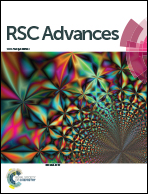Engineering disorder into exotic electronic 2D TiO2 nanosheets for enhanced photocatalytic performance†
Abstract
We successfully prepared exotic electronic 2D TiO2 nanosheets and then engineered disorder into them to obtain black TiO2 nanosheets. The structural changes induced by this engineering were carefully investigated. The salient properties of the black TiO2 nanosheets were made evident by their enhanced photocurrent and H2 evolution properties.


 Please wait while we load your content...
Please wait while we load your content...